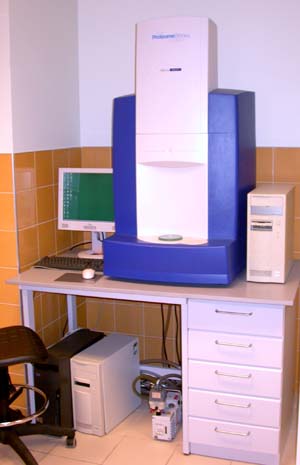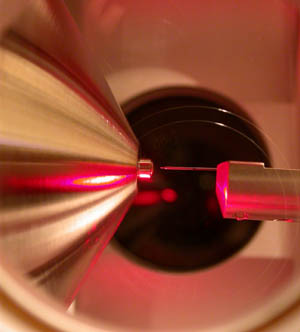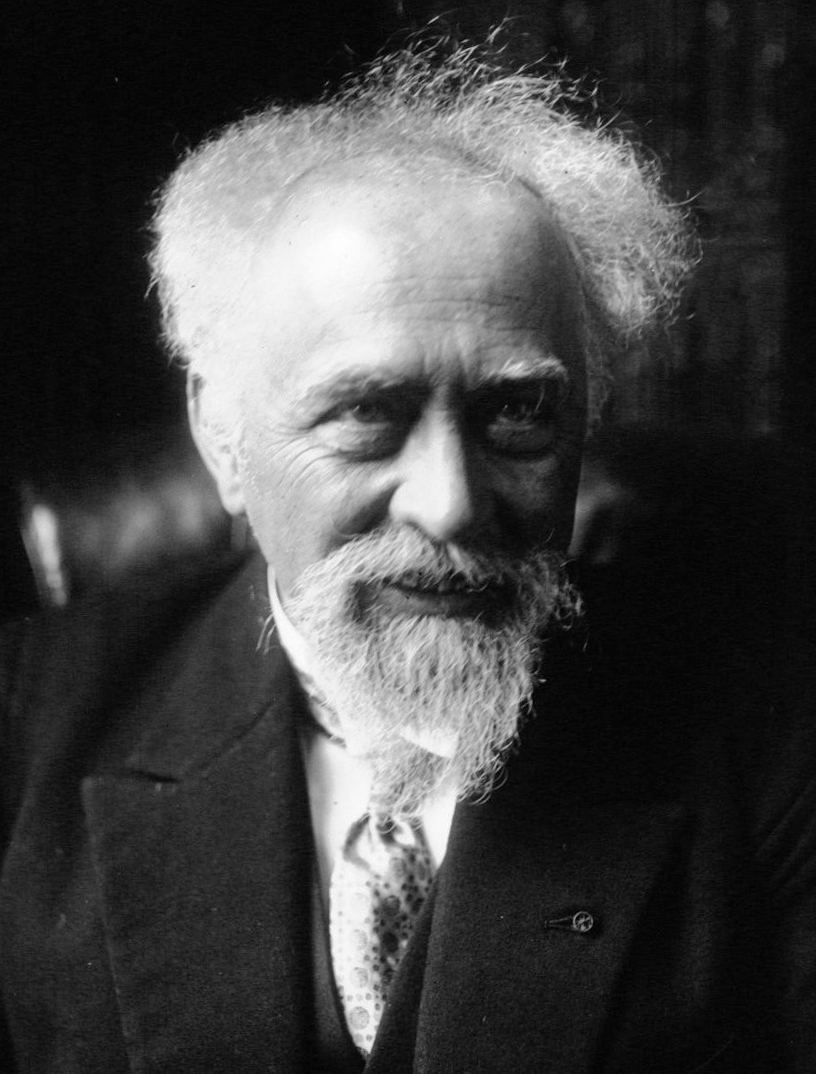|
MALDI
In mass spectrometry, matrix-assisted laser desorption/ionization (MALDI) is an ionization technique that uses a laser energy-absorbing matrix to create ions from large molecules with minimal fragmentation. It has been applied to the analysis of biomolecules (biopolymers such as DNA, proteins, peptides and carbohydrates) and various organic molecules (such as polymers, dendrimers and other macromolecules), which tend to be fragile and fragment when ionized by more conventional ionization methods. It is similar in character to electrospray ionization (ESI) in that both techniques are relatively soft (low fragmentation) ways of obtaining ions of large molecules in the gas phase, though MALDI typically produces far fewer multi-charged ions . MALDI methodology is a three-step process. First, the sample is mixed with a suitable matrix material and applied to a metal plate. Second, a pulsed laser irradiates the sample, triggering ablation and desorption of the sample and matrix materi ... [...More Info...] [...Related Items...] OR: [Wikipedia] [Google] [Baidu] |
MALDITOF
In mass spectrometry, matrix-assisted laser desorption/ionization (MALDI) is an ionization technique that uses a laser energy-absorbing matrix to create ions from large molecules with minimal fragmentation. It has been applied to the analysis of biomolecules (biopolymers such as DNA, proteins, peptides and carbohydrates) and various organic molecules (such as polymers, dendrimers and other macromolecules), which tend to be fragile and fragment when ionized by more conventional ionization methods. It is similar in character to electrospray ionization (ESI) in that both techniques are relatively soft (low fragmentation) ways of obtaining ions of large molecules in the gas phase, though MALDI typically produces far fewer multi-charged ions . MALDI methodology is a three-step process. First, the sample is mixed with a suitable matrix material and applied to a metal plate. Second, a pulsed laser irradiates the sample, triggering ablation and desorption of the sample and matrix material ... [...More Info...] [...Related Items...] OR: [Wikipedia] [Google] [Baidu] |
Franz Hillenkamp
Franz Hillenkamp (March 18, 1936 – August 22, 2014) was a German scientist known for his development of the laser microprobe mass analyzer and, with Michael Karas, matrix-assisted laser desorption/ionization (MALDI). Early life and education Franz Hillenkamp was born in 1936 in Essen, Germany. He attended high school in Lünen, graduating in 1955. He received a M.S. degree in electrical engineering from Purdue University in 1961. He received a Ph.D. (Dr.-Ing.) from the Technische Universität München in 1966 with a thesis entitled “An Absolutely Calibrated Calorimeter for the Measurement of Pulsed Laser Radiation.” Academic career Hillenkamp was a professor at Goethe University Frankfurt in Frankfurt from 1982 to 1986. In 1986, he became a professor on the Medical Faculty of the University of Münster where he remained until his retirement in 2001. Laser microprobe In 1973, Hillenkamp developed a high performance laser microprobe mass spectrometer with a spatial resolut ... [...More Info...] [...Related Items...] OR: [Wikipedia] [Google] [Baidu] |
Mass Spectrometry
Mass spectrometry (MS) is an analytical technique that is used to measure the mass-to-charge ratio of ions. The results are presented as a ''mass spectrum'', a plot of intensity as a function of the mass-to-charge ratio. Mass spectrometry is used in many different fields and is applied to pure samples as well as complex mixtures. A mass spectrum is a type of plot of the ion signal as a function of the mass-to-charge ratio. These spectra are used to determine the elemental or isotopic signature of a sample, the masses of particles and of molecules, and to elucidate the chemical identity or structure of molecules and other chemical compounds. In a typical MS procedure, a sample, which may be solid, liquid, or gaseous, is ionization, ionized, for example by bombarding it with a Electron ionization, beam of electrons. This may cause some of the sample's molecules to break up into positively charged fragments or simply become positively charged without fragmenting. These ions (fragmen ... [...More Info...] [...Related Items...] OR: [Wikipedia] [Google] [Baidu] |
Koichi Tanaka
is a Japanese electrical engineer who shared the Nobel Prize in Chemistry in 2002 for developing a novel method for mass spectrometric analyses of biological macromolecules with John Bennett Fenn and Kurt Wüthrich (the latter for work in NMR spectroscopy). Early life and education Tanaka was born and raised in Toyama, Japan, his biological mother died one month after he was born. Tanaka graduated from Tohoku University with a bachelor's degree in electrical engineering in 1983, afterward he joined Shimadzu Corporation, where he engaged in the development of mass spectrometers. Soft laser desorption For mass spectrometry analyses of a macromolecule, such as a protein, the analyte must be ionized and vaporized by laser irradiation. The problem is that the direct irradiation of an intense laser pulse on a macromolecule causes cleavage of the analyte into tiny fragments and the loss of its structure. In February 1985, Tanaka found that by using a mixture of ultra fine metal ... [...More Info...] [...Related Items...] OR: [Wikipedia] [Google] [Baidu] |
Electrospray Ionization
Electrospray ionization (ESI) is a technique used in mass spectrometry to produce ions using an electrospray in which a high voltage is applied to a liquid to create an aerosol. It is especially useful in producing ions from macromolecules because it overcomes the propensity of these molecules to fragment when ionized. ESI is different from other ionization processes (e.g. matrix-assisted laser desorption/ionization, MALDI) since it may produce multiple-charged ions, effectively extending the mass range of the analyser to accommodate the kDa-MDa orders of magnitude observed in proteins and their associated polypeptide fragments. Mass spectrometry using ESI is called electrospray ionization mass spectrometry (ESI-MS) or, less commonly, electrospray mass spectrometry (ES-MS). ESI is a so-called 'soft ionization' technique, since there is very little fragmentation. This can be advantageous in the sense that the molecular ion (or more accurately a pseudo molecular ion) is almost alw ... [...More Info...] [...Related Items...] OR: [Wikipedia] [Google] [Baidu] |
Michael Karas
Michael Karas (born 1952) is a German physical chemistry scientist and Professor, known for his researches on matrix-assisted laser desorption/ionization (MALDI), a technique in mass spectrometry. Michael Karas studied Chemistry at the University of Bonn, where he obtained a PhD in the field of physical chemistry in 1982. From 1983 to 1986, he was part of the Hillenkamp research group in the Institut für Biophysik at Goethe University Frankfurt. In 1987, he followed Hillenkamp at Münster and both formed a group in the Faculty of Medicine at University of Münster. He returned to Frankfurt in 1995 as a full professor for Instrumental Analytical Chemistry. Awards * 1997: Recipient of the John B. Fenn Award for a Distinguished Contribution in Mass Spectrometry * 2003: Karl Heinz Beckurts Award, Germany’s most important award for outstanding promotion of the partnership between science and industry * 2006: Thomson Medal awarded by the International Mass Spectrometry Foundation ... [...More Info...] [...Related Items...] OR: [Wikipedia] [Google] [Baidu] |
Nitrogen Laser
A nitrogen laser is a gas laser operating in the ultraviolet rangeC. S. Willett, ''Introduction to Gas Lasers: Population Inversion Mechanisms'' (Pergamon, New York,1974). (typically 337.1 nm) using molecular nitrogen as its gain medium, laser pumping, pumped by an electrical discharge. The wall-plug efficiency of the nitrogen laser is low, typically 0.1% or less, though nitrogen lasers with efficiency of up to 3% have been reported in the literature. The wall-plug efficiency is the product of the following three efficiencies: * electrical: TEA laser * gain medium: This is the same for all nitrogen lasers and thus has to be at least 3% ** inversion by electron impact is 10 to 1 due to Franck–Condon principle ** energy lost in the lower laser level: 40% * optical: More stimulated emission than spontaneous emission Gain medium The gain medium is nitrogen molecules in the gas phase. The nitrogen laser is a three-level laser. In contrast to more typical four-level lasers, the ... [...More Info...] [...Related Items...] OR: [Wikipedia] [Google] [Baidu] |
Glycerol
Glycerol () is a simple triol compound. It is a colorless, odorless, sweet-tasting, viscous liquid. The glycerol backbone is found in lipids known as glycerides. It is also widely used as a sweetener in the food industry and as a humectant in pharmaceutical formulations. Because of its three hydroxyl groups, glycerol is miscible with water and is Hygroscopy, hygroscopic in nature. Modern use of the word glycerine (alternatively spelled glycerin) refers to commercial preparations of less than 100% purity, typically 95% glycerol. Structure Although chirality, achiral, glycerol is prochirality, prochiral with respect to reactions of one of the two primary alcohols. Thus, in substituted derivatives, the Glycerophospholipid#Nomenclature and stereochemistry, stereospecific numbering labels the molecule with a ''sn''- prefix before the stem name of the molecule. Production Natural sources Glycerol is generally obtained from plant and animal sources where it occurs in triglycerides, est ... [...More Info...] [...Related Items...] OR: [Wikipedia] [Google] [Baidu] |
Cobalt
Cobalt is a chemical element; it has Symbol (chemistry), symbol Co and atomic number 27. As with nickel, cobalt is found in the Earth's crust only in a chemically combined form, save for small deposits found in alloys of natural meteoric iron. The free element, produced by reductive smelting, is a hard, lustrous, somewhat brittle, gray metal. Cobalt-based blue pigments (cobalt blue) have been used since antiquity for jewelry and paints, and to impart a distinctive blue tint to glass. The color was long thought to be due to the metal bismuth. Miners had long used the name ''kobold ore'' (German language, German for ''goblin ore'') for some of the blue pigment-producing minerals. They were so named because they were poor in known metals and gave off poisonous arsenic-containing fumes when smelted. In 1735, such ores were found to be reducible to a new metal (the first discovered since ancient times), which was ultimately named for the ''kobold''. Today, some cobalt is produced sp ... [...More Info...] [...Related Items...] OR: [Wikipedia] [Google] [Baidu] |
International Journal Of Mass Spectrometry And Ion Processes
International is an adjective (also used as a noun) meaning "between nations". International may also refer to: Music Albums * ''International'' (Kevin Michael album), 2011 * ''International'' (New Order album), 2002 * ''International'' (The Three Degrees album), 1975 *''International'', 2018 album by L'Algérino Songs * The Internationale, the left-wing anthem * "International" (Chase & Status song), 2014 * "International", by Adventures in Stereo from ''Monomania'', 2000 * "International", by Brass Construction from ''Renegades'', 1984 * "International", by Thomas Leer from ''The Scale of Ten'', 1985 * "International", by Kevin Michael from ''International'' (Kevin Michael album), 2011 * "International", by McGuinness Flint from ''McGuinness Flint'', 1970 * "International", by Orchestral Manoeuvres in the Dark from '' Dazzle Ships'', 1983 * "International (Serious)", by Estelle from '' All of Me'', 2012 Politics * Internationalism (politics) * Political international, ... [...More Info...] [...Related Items...] OR: [Wikipedia] [Google] [Baidu] |
Melittin
Melittin is the main component (40–60% of the dry weight) and the major pain-producing substance of honeybee (''Apis mellifera'') venom. Melittin is a basic peptide consisting of 26 amino acids. Function The principal function of melittin as a component of bee venom is to cause pain and destruction of tissue of intruders that threaten a beehive. However, in honey bees, melittin is not only expressed in the venom gland, but also in other tissues when infected with pathogens. The two venom molecules, melittin and secapin, that are over-expressed in honey bees infected with various pathogens, possibly indicate a role for melittin in the immune response of bees to infectious diseases. Structure Melittin is a small peptide with no disulfide bridge; the ''N''-terminal part of the molecule is predominantly hydrophobic and the ''C''-terminal part is hydrophilic and strongly basic. In water, it forms a tetramer but it also can spontaneously integrate itself into cell membra ... [...More Info...] [...Related Items...] OR: [Wikipedia] [Google] [Baidu] |
Dalton (unit)
The dalton or unified atomic mass unit (symbols: Da or u, respectively) is a unit of mass defined as of the mass of an Bound state, unbound neutral atom of carbon-12 in its nuclear and electronic ground state and invariant mass, at rest. It is a Non-SI units mentioned in the SI, non-SI unit accepted for use with SI. The word "unified" emphasizes that the definition was accepted by both IUPAP and IUPAC. The atomic mass constant, denoted , is defined identically. Expressed in terms of , the atomic mass of carbon-12: . Its value in International System of Units, SI units is an experimentally determined quantity. The 2022 CODATA recommended value of the atomic mass constant expressed in the SI base unit kilogram is:This value serves as a Conversion of units, conversion factor of mass from daltons to kilograms, which can easily be converted to Gram, grams and other metric units of mass. The 2019 revision of the SI redefined the kilogram by fixing the value of the Planck constant (), i ... [...More Info...] [...Related Items...] OR: [Wikipedia] [Google] [Baidu] |





